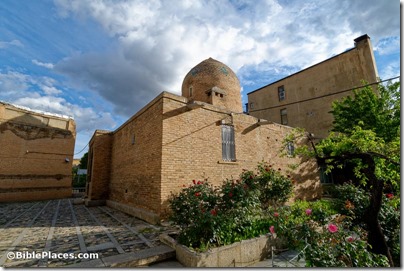A scholarly study uses radiocarbon dating to determine that “Wilson’s Arch was initiated by Herod the Great and enlarged during the Roman Procurators, such as Pontius Pilatus, in a range of 70 years, rather than 700 years, as previously discussed by scholars. The theater-like structure is dated to the days of Emperor Hadrian and left unfinished before 132–136 AD.”
“A 1,800-year-old fountainhead in the shape of a face was uncovered by chance by a visitor at the Tzipori [Sepphoris] National Park in the Galilee.”
Rami Arav discusses his excavations at et-Tell and a newly discovered moon god stele (Haaretz premium).
Excavations will not be possible at el-Araj (Bethsaida?) this summer because of the high water level. The article includes many photos.
NPR has a story on the Israeli and Jordanian sides of the tourist site for Jesus’s baptism, including a discussion of creating a new “soft crossing” to allow tourists to enter Jordan from the Israeli side.
A new study of the DNA of 35 fragments from the Dead Sea Scrolls is providing insight into the diverse origins of the parchments.
Mark Vitalis Hoffman has published an interesting article on “Jesus and Jerusalem and the ‘Things That Make for Peace.” He has also created a video to supplement the article.
Gabriel Barkay is on The Book and the Spade this week talking about the archaeology of Jerusalem’s Temple Mount.
Israel’s Good Name had a productive trip scouting out the birds and fish at the Beit Zayit Reservoir west of Jerusalem.
A Jerusalem Post piece looks at the resumption of tourism in Israel and the safety measures being put in place.
From boom to bust: with tourism in Israel all but gone, tour guides are considering their options.
The Winter 2019 issue of the ACOR Newsletter is now available (high-res; low-res).
The Bible and Interpretation provides a selection about ancient Moab and the Mesha Stele from the new book by Burton MacDonald.
Gulf News has a write-up on artifacts from Saudi Arabia that are featured in the traveling “Roads of Arabia” exhibit.
Smithsonian magazine has a long, well-illustrated piece on archaeological work in and around Aigai, Philip II’s capital of Macedon. A massive new museum is scheduled to open in January.
The latest historical city travel guide by the British Museum is of Athens in the 5th century BC.
Some stories on re-opening: excavations in Turkey, Vatican Museums, Rome’s Colosseum, Pompeii, Al Ula, Israel’s museums, the Temple Mount.
Two Asian lion cubs were recently born at the Jerusalem Biblical Zoo.
HT: Joseph Lauer, Chris McKinny, Agade, Keith Keyser, Steven Anderson, Charles Savelle, Explorator
![Church of the Holy Sepulcher locked, nf7550-sr_thumb[1] Church of the Holy Sepulcher locked, nf7550-sr_thumb[1]](https://www.bibleplaces.com/wp-content/uploads/2020/05/Church-of-the-Holy-Sepulcher-locked-nf7550-sr_thumb1_thumb.jpg)
